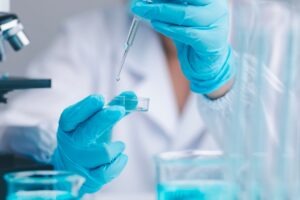A major international collaboration involving hundreds of researchers worldwide has identified seventy-two new genetic variants that contribute to the risk of developing breast cancer.
Subscribe to our email newsletter
Of these variants, reported today in the journals Nature and Nature Genetics, 65 are common variants that predispose to breast cancer and a further seven predispose specifically to oestrogen-receptor negative breast cancer – the subset of cases that do not respond to hormonal therapies, such as the drug tamoxifen.
Breast cancer is caused by complex interactions between a large number of genetic variants and our environment. The inherited component of breast cancer risk is due to a combination of rare variants in genes such as BRCA1 and BRCA2 that confer a high risk of the disease, and many commoner genetic variants that each confer only a small risk. The newly identified risk regions nearly double the number that are already known, thereby bringing the number of known common variants associated with breast cancer to around 180.
The findings are the result of work by the OncoArray Consortium, a huge endeavour involving 550 researchers from around 300 different institutions in six continents. In total, they analysed genetic data from 275,000 women, of whom 146,000 had been diagnosed with breast cancer.
Professor Doug Easton from the Centre for Cancer Genetic Epidemiology and a Fellow at Homerton College, the University of Cambridge, one of the lead investigators on the study, says: “These findings add significantly to our understanding of the inherited basis of breast cancer. As well as identifying new genetic variants, we have also confirmed many that we had previously suspected. There are some clear patterns in the genetic variants that should help us understand why some women are predisposed to breast cancer, and which genes and mechanisms are involved.”
By combining epidemiological data with other data from breast tissue, the researchers were able to make plausible predictions of the target genes in the large majority of cases. In addition, they showed for the first time that these genes are often the same as those that are altered in breast tumours – when a tumour develops, the DNA within the cancer cells themselves mutates.
Most of the variants found by OncoArray were not found within genes, but rather within regions of the genome that regulate the activity of nearby genes. When the researchers looked at the pattern of these genetic regions, they discovered that this differed from that of those regions involved in predisposition to other common diseases.
Professor Peter Kraft at Harvard TH Chan School of Public Health, USA, says: “Given the size of these studies, we expected that we would find a lot of new breast cancer risk variants, but the studies tells us a lot more about which genes are involved, revealing many previously unsuspected genes and genetic mechanisms underlying breast carcinogenesis. This should provide guidance for a lot of future research.”
Around 70% of all cases of breast cancer are oestrogen-receptor positive, meaning that the cancer cells have a particular protein (known as a receptor) that responds to the female sex hormone oestrogen, enabling the tumour to grow. However, not all cancer cells carry this receptor – these are known as oestrogen-receptor negative. The studies identified genetic regions specifically associated with either oestrogen-receptor positive or oestrogen receptor negative breast cancer, underscoring the fact that these are biologically distinct cancers that develop differently.
“These findings may inform improved risk prediction, both for the general population and BRCA1 mutation carriers,” says Associate Professor Roger Milne at Cancer Council Victoria in Melbourne. “A better understanding of the biological basis of oestrogen receptor negative breast cancer may lead to more effective preventive interventions and treatments.”
The risk variants identified in the two studies are common: while some are carried by one woman in a hundred, others are carried by more half of all women. Individually, the risks conferred by each variant are modest; however, because they are common and their effects multiply together, the combined effect is considerable. For example, the researchers estimated that one percent of women have a risk of breast cancer that is more than 3 times greater than the population at large. Larger differences in risk can be found if the genetic variants are combined with other hormonal and lifestyle factors that influence breast cancer risk.
The researchers believe these differences may be sufficient to change practice, such as in how women at different risks are screened. In many countries, women are offered screening by mammography from age 50; women at increased risk because of a family history can be offered screening earlier, and those at particularly high risk can be offered screening by MRI, which is more sensitive.
“Using data from genomic studies, combined with information on other known risk factors, will allow better breast cancer risk assessment, therefore helping to identify a small but meaningful proportion of women at high risk of breast cancer,” says Professor Jacques Simard at Université Laval, Quebec city, Canada.
“These women may benefit from more intensive screening, starting at a younger age, or using more sensitive screening techniques, allowing early detection and prevention of the disease. At the same time, this personalised information will also be useful to adapt screening modalities for women at substantially lower risk.”
Professor Karen Vousden, Cancer Research UK’s chief scientist, said: “This study is a great example of how international collaboration can help improve the understanding of cancer. The results, gathered from around the world, help pinpoint the genetic changes linked to a women’s risk of breast cancer. Learning which women are at higher risk of breast cancer could help identify who may benefit from earlier screening, and spare women at a lower risk from having to attend screening if it’s unlikely to benefit them.”
 Advertise With UsAdvertise on our extensive network of industry websites and newsletters.
Advertise With UsAdvertise on our extensive network of industry websites and newsletters.
 Get the PBR newsletterSign up to our free email to get all the latest PBR
news.
Get the PBR newsletterSign up to our free email to get all the latest PBR
news.

